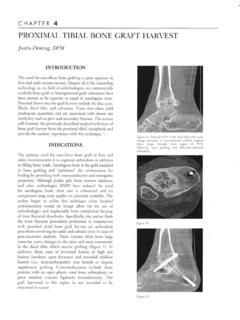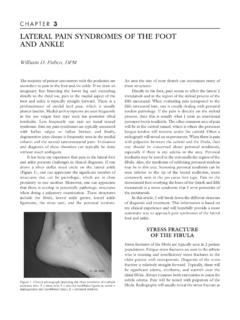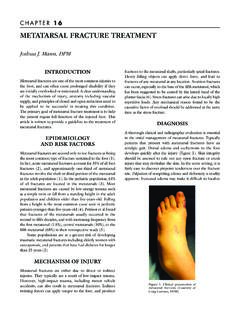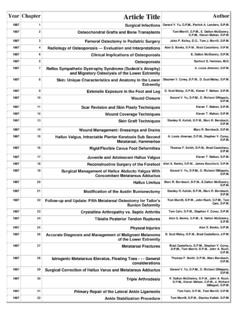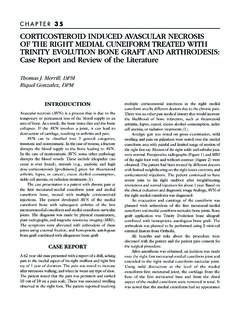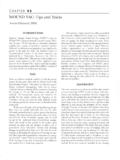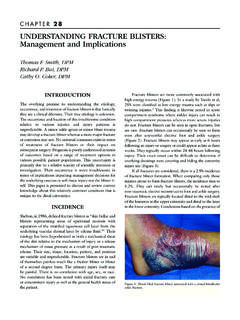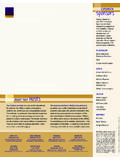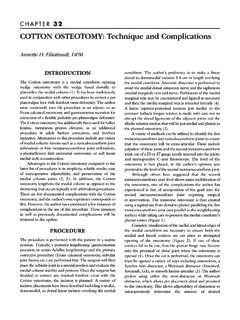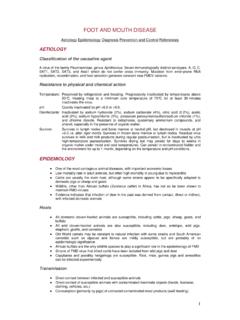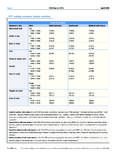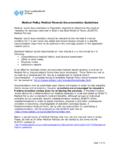Transcription of MALIGNANT SOFT TISSUE LESIONS OF THE FOOT …
1 CHAPTER 48 MALIGNANT soft TISSUE LESIONSOF THE foot AND ANKLE,Tbm Jordan, PMSW illiam Bowman, MDClay Ballinger, DPMD onald Creen, DPMINTRODUCTIONSoft TISSUE is derived from mesoderm with some conrri-bution of nonepithelial TISSUE comprised of thereticuloedothelial system, glia, and supporting TISSUE (Figure i).'\X/ithin the various histologic categories, softtissue tumors are divided into benign and malignantforms. Benign tumors more ciosely resemble normaltissue and exhibit little tendency to invade locally(Figure 2). MALIGNANT soft TISSUE tumors, or sarcomas, arelocally aggressive and capable of destructive growth anddistant metastasis (Figure 3).
2 soft TISSUE sarcomas of thefoot and ankle are rare, with the majority consisting ofsynovial cell sarcoma, fibrosarcoma, clear cell sarcoma,liposarcoma, and MALIGNANT fibrous histocytoma.''r Ofthese 5 tumors, synovial sarcomas occur with the greatestFigure 2. Benign tumors are generallv distinct Iesionsthat are weil circumscribed and often generallv do nor cross tissrLe 1.'Ihese soft TISSUE LESIONS are plantar fibromatoses. Fibrous appear lrom the plantar fascia. Although benign, they can appearaggressive under :r microscope and may be misread as MALIGNANT if thepathologist doesn't knolv the part of the body from where the,v 3.
3 MALIGNANT tumors such as this malignantfibrous hl, are often fast grorving LESIONS thatare not often distinct nor well circumscribed. They oftenharre no regard for TISSUE planes as can be seen CHAPTER48frequency. Leiomyosarcoma, rhabdomyosarcoma, angis-arcoma, and MALIGNANT schwannoma are also found in thefoot and ankle, but with much less 't foot andankle sarcomas have a more benign course than sarcomasat other TISSUE tumors occur everl'where in the human body,however most arise in the trunk and proximal extremitiesbecause of the high TISSUE volume in these areas. In arerrospecrive review of 39,179 soft TISSUE LESIONS seenfrom 1980 to 1989 at the Armed Forces Institute ofpathology, 8o/o of all benign soft TISSUE tumors and 5o/oof all MALIGNANT soft TISSUE tumors occurred in the footand et al retrospectively analyzed 83 patients whohad a soft TISSUE tumor in the foot and 72 (87o/o) of thelesions were benign, while the remaining 11 (13%) weremalignant.
4 ' Five of the 11 MALIGNANT tumors weresynovial sarcomas. The age of the patient and the locationof the LESIONS were the most important factors thatcharacterized the MALIGNANT tumors in this of symptoms, history of trauma, and the size ofthe lesion were not useful discriminators betweenmalignant tumors and benign a more recent study, 252 cases of MALIGNANT softtissue neoplasms of the foot were examined from a majormedical center specializing in the treatment of cancer. Themost common MALIGNANT soft TISSUE tumors were synovialsarcoma (24o/o) followed by clear cell sarcoma (l2o/o),fibrosarcoma (11olo), MALIGNANT fibrous histocytoma (9%)and liposarco ma (5o/o).
5 2 The differential diagnosis for synovial sarcomas,clear cell sarcomas, fibrosarcomas, MALIGNANT fibroushistocytoma and liposarcomas are quite extensive and caninclude any subcutaneous soft TISSUE mass of the foot orankle. The differential diagnosis includes but is notIimited to ganglion cyst (the most common soft tissuelesion in the foot and ankle), lipoma, fibroma, synovialcyst, giant cell tumor of the tendon sheath, pigmentedvillonodular synovitis, neurofibroma, epidermal inclusioncyst, Ieiomyoma, leiomyosarcoma, rhabdomyoma, A detailed history, thorough exam,and adjunctive tests including radiographs, magneticresonance imaging (MRI), and computed tomography(CT) are important for an accurate diagnosis.
6 A definitivediagnosis is made by histological studies from a fineneedle aspiration, core needle aspiration, or 'SYNOVIAL SARCOMAS ynovial sarcomas are the most common sarcoma of thefoot representing 5o/o of all soft TISSUE tumors, andcompromising25 to 560/o of al| MALIGNANT ''o Themost common site of presentation is the knee followed bythe foot and ankle region (Figure 4).'o'" Synovial sarcomasare most commonly identified over the dorsum of thefoot along the course of the extensor tendons, or near ajoint, and are therefore often mistaken for a commonlyoccurring ganglion cysts upon first ' Thistumor does not originate from synovial structures, butrather has a true epithelial component distinguished by itshistological keratin expression.
7 A highly organizedrelationship exists between epithelial and spindle The biphasic histological type containsboth epithelial and spindle components, while themonophasic type is a spindle cell tumor with noepithelial component. roSynovial sarcomas have a tendency to arise in youngadults between the ages of 15 and 40 years.' On average,the delay between the onset of symptoms and subsequenttreatment is 1B to 24 months because they usualiy remainquiescent for a long period of time." As with all other softtissue neoplasms of the foot or ankle, the most commonclinical signs and symptoms are pain, tenderness, edema,and an enlarging mass.
8 A careful sensory examination ofthe cutaneous innervation of the foot may provide theextent of neoplasm spread.'Figure 4. This synovial sarcoma is a solid lesior on thelateral midfoot rearfoot area. The patient rv,ras havingdifficulry wearing 281 Immunohistochemistry studies are necessary in orderto make a definitive diagnosis. Most poorlv differentiatedsynovial sarcomas are immunoreactive for cytokeratin,epithelial membrane antigen, vimentin, CD99 and S100;negative for CD34, and negative for desmin." Reactivity ofCD99 is an important indicator for a poorly differentiatedsynovial sarcoma.''Indications for tumor severiry are not uniformamong different studies.
9 In a study by Scully et al of the 14patients with synovial sarcoma of the foot or ankle, thosewith biphasic histological features of epithelial and spindlecomponents had better outcomes than those withmonophasic Also, patients with prolongedsymptoms before diagnosis had better outcomes. It washypothesizes that patients with prolonged symptoms hadslower growing, less aggressive tumors. In a different studywhere a prospective analysis was performed on 48 patientswith extremiq. and truncal synovial sarcomas, tumor size,margin of resection and mitotic activity were prognosticfactors for survival while grade, histologic subrype andtumor site were not.
10 ' The tumor will most oftenmetastasize to the lungs followed by the lymph nodes andthe bone Once the lesion matastasises, theoutcome is often The five-year survival rate forsynovial sarcoma is between 360/o and 650/o and has beenfound to metastasize or recur in 50o/o to 70o/o of cases."CLEAR CELL SARCOMAC lear cell sarcoma (CCS) is a slow growing soft tissuetumor commonly associated with tendons and aponeurosesin the extremities of young adults between the ages of 20and 40 years (Figure 5)." CCS represented 23 our of 189(I2o/o) of all soft rissue sarcomas of the foot and ankle inFigure 5. This clear ccll sarcoma is somewhat unusual as it involved bone.
